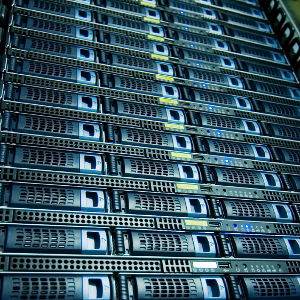
Advance Your Data Analytics Performance in a ‘Flash’

According to Deep Thought, the supercomputer from the sci-fi classic Hitchhiker’s Guide to the Galaxy, the answer to the meaning of life is the number 42. This goes to show that simply having data doesn’t necessarily translate to valuable insights. True value comes from context by placing data within the right parameters at the right time and with search, analysis, and visualization capabilities.
To help put this data into context, IT departments and data scientists need to develop and continually evolve the right infrastructure to manage and process data. In order to obtain meaningful, actionable results (such as the answer to the meaning of life) from structured and unstructured data quickly, greater performance and timely visibility is absolutely critical.
Data explosion is not showing any signs of plateauing in near future. Easy to use, powerful operational intelligence and open source distributed solutions are becoming the industry standard today. Additionally, the synergies of the Internet of Things – social, mobile, analytics and the cloud – are unlocking new value in big data. Previously untapped sources of data are now yielding new customer insights at the granular level never possible before.
In fact, IDC recently released a forecast showing that the big data technology and services market growing at a compound annual growth rate (CAGR) of 23.1 percent over the 2014-2019 forecast period with annual spending reaching $48.6 billion in 2019. Lower costs and new data sources are leading to this surge of analytics adoption, which is in part driving the digital transformation of businesses around the globe. Given the fast changing business landscape fueled by rising competitive and customer demands, organizations can no longer risk becoming irrelevant by ignoring the analytics edge.
As technology evolves, the benefits of big data will only become more apparent. However, technology advancements are also aiding data growth and system complexity. So, how should companies approach these challenges? How can organizations future proof their businesses to gain the most value and insight from their analytics?
Data Giveth, Data Taketh Away
You might be asking: how is more data a challenge for big data? Well, while data is the proverbial lifeblood of analytics, too much of it can wreak havoc on systems, drastically affecting performance and uptime if not managed properly.
A recent Cisco Systems report projects the global Internet traffic will exceed the zettabyte (1,000 exabytes) threshold by the end of 2016. IDC estimates also notes that the world’s data will reach 44 zettabytes by 2020, a tenfold increase from 2014. At the center of this growth is the Internet of Things: millions of connected devices collecting and feeding in data to analytics teams in real-time. The Cisco report found that over two-thirds of all IP traffic would be generated by non-PC devices by 2019.
Businesses employing analytics today need to understand the challenge this growth poses. It is critical that IT environments can manage the workloads of not only today, but also the heavy data workloads of tomorrow.
Thankfully, next generation analytics and storage solutions that can better manage the incoming surge of data, while simplifying IT infrastructure, are becoming available now.
Accelerating Value
One of the big draws of analytics for companies is the ability to analyze data (mobile, social, CRM, etc.) in real-time, gathering invaluable insights and optimizing corporate strategy, tactics and resources on the fly. This is predicated on the company’s ability to capture, manage, and process its data across its infrastructure efficiently. Technologies that can boost performance, improve reliability and simplify IT will be integral for organizations hoping to reap the benefits of big data analytics.
For example, solutions that can boost performance for high-IOPS and low-latency applications such as all-flash systems will be the tools of choice in the years to come. Additionally, capturing and managing the data from the growing amount of social and mobile users can strain legacy relational databases running on slow storage. The latest platforms and storage systems offer the linear performance scaling and reliability needed for the time sensitive actions of today and tomorrow.
Big Data Analytics in Action
Whether it’s a global bank’s DevOps team testing applications, a retailer trying to better understand its customers, or a manufacturer trying to streamline its supply chain, the more data a company can process quickly and effectively will be the difference between an industry leader and getting left behind.
ING DIRECT Australia is seen as an innovator in the financial services industry and demonstrates the value of leveraging the latest analytics and storage to boost performance, and ultimately deliver more value to its customers. The company is known for pushing the boundaries, offering unique time and cost saving solutions for customers around the world. Despite this, the company struggled to bring new ideas and offerings through to fruition due to a large project backlog and out-dated test system. The development and test infrastructure simply could not meet the bank’s appetite for innovation.
ING DIRECT Australia developed its integrated “Bank in a Box” solution to help accelerate its innovation and allow new applications and services to be delivered to customers even more rapidly. Basically, the Bank in the Box enabled rapid provisioning of complete IT environments; providing a copy of the bank to anyone, at anytime, for any purpose at the lowest cost to test new offerings across the bank’s systems, applications and configurations and 5.5 terabytes of data.
By adopting an innovative, data-driven solution, ING DIRECT’s development team could now provision complete environments in minutes, as opposed to months. The project improved developer productivity with self-service provisioning, automating a process that previously took eight people three months to just ten minutes now; as well as streamlining the development, test, and deployment phases of delivery into one integrated end-to-end solution.
Don’t Panic
The rise of data given advancements in technologies, such as the Internet of Things, is an opportunity for businesses to succeed. While big data and analytics will play a vital role in becoming a differentiator for businesses in rapidly transitioning markets, they need to be backed by the right IT infrastructure to deliver the desired outcome.
We live in an age where big data is only as good as the timely insights it can help generate qualitatively for better decisions. Next generation flash technologies can help empower data-driven organizations across the globe unleash the value out of data, by cutting down latency, boosting performance, simplifying IT, reducing costs and ensuring reliability.
About the author: Mike McNamara is a senior manager of product and solution marketing at NetApp  with 25 years of storage and data management marketing experience. Before joining NetApp over 10 years ago, Mike worked at Adaptec, EMC and Digital Equipment Corporation. Mike was a key leader driving the launch of the industry’s first unified scale-out storage system (NetApp), iSCSI and SAS storage system (Adaptec), and Fibre Channel storage system (EMC CLARiiON ). In addition to his past role as marketing chairperson for the Fibre Channel Industry Association, he is a member of the Ethernet Technology Summit Conference Advisory Board, a member of the Ethernet Alliance, a regular contributor to industry journals, and a frequent speaker at events. Mike graduated from Fairfield University, Fairfield CT with a Bachelor’s degree in Business Management from the Dolan School of Business, and holds an MBA from Clark University’s Graduate School of Management, Worcester, MA.
with 25 years of storage and data management marketing experience. Before joining NetApp over 10 years ago, Mike worked at Adaptec, EMC and Digital Equipment Corporation. Mike was a key leader driving the launch of the industry’s first unified scale-out storage system (NetApp), iSCSI and SAS storage system (Adaptec), and Fibre Channel storage system (EMC CLARiiON ). In addition to his past role as marketing chairperson for the Fibre Channel Industry Association, he is a member of the Ethernet Technology Summit Conference Advisory Board, a member of the Ethernet Alliance, a regular contributor to industry journals, and a frequent speaker at events. Mike graduated from Fairfield University, Fairfield CT with a Bachelor’s degree in Business Management from the Dolan School of Business, and holds an MBA from Clark University’s Graduate School of Management, Worcester, MA.






























